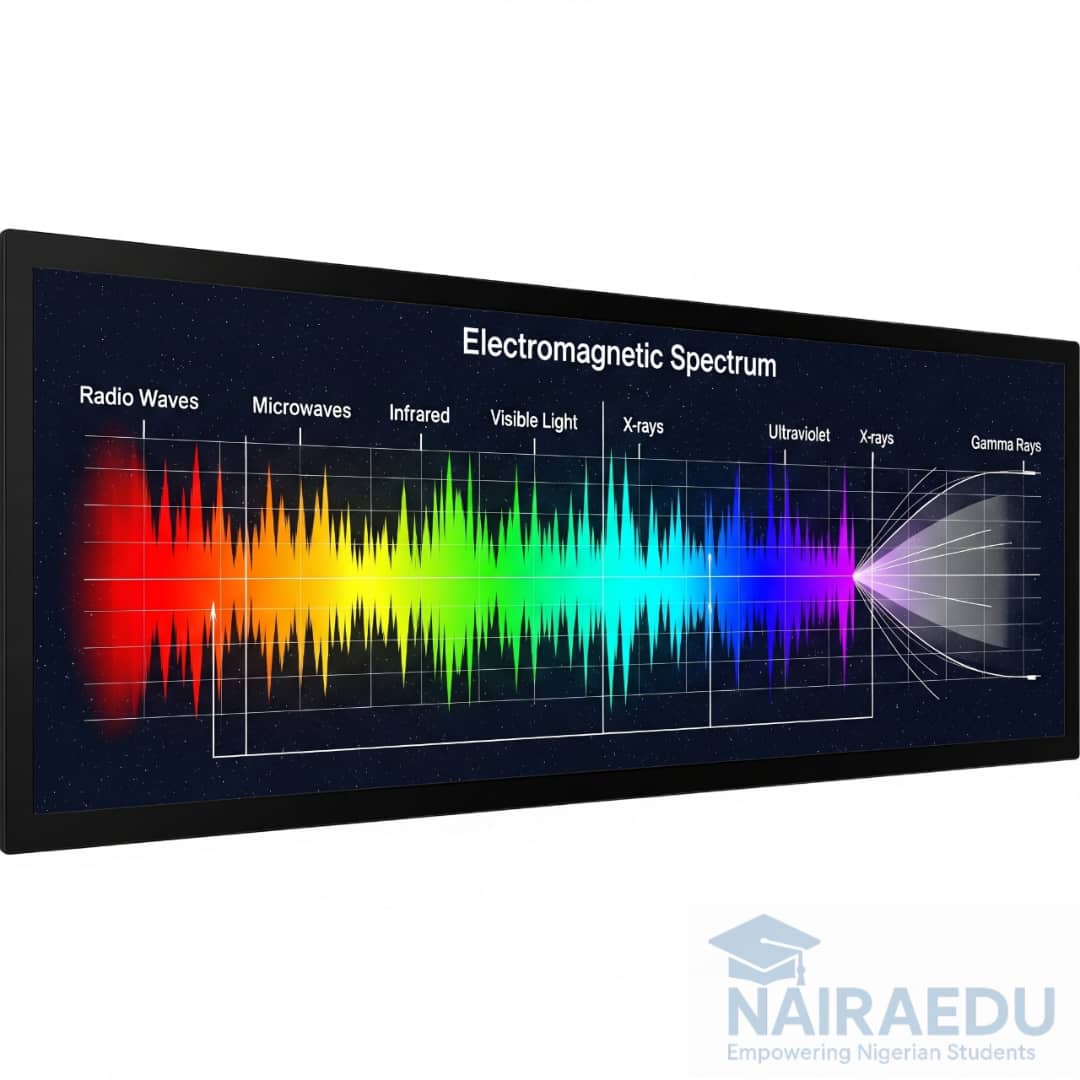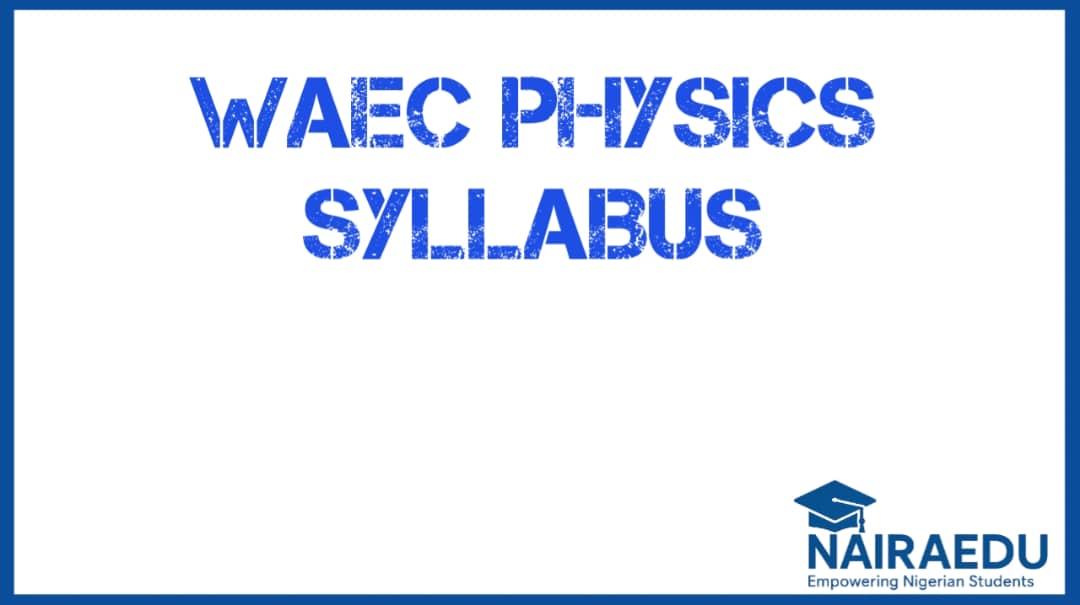The WAEC Syllabus for Physics 2026 is the essential course outline for all students preparing for the West African Senior School Certificate Examination (WASSCE). At Nairaedu.com, we understand that Physics can be a challenging subject, but with the right guide, it can also be one of the most rewarding.
This meticulously detailed guide breaks down the entire syllabus, discusses the structure of the exam, and provides actionable tips to help you master every topic and achieve an A1.
The syllabus covers fundamental principles in mechanics, heat energy, waves, electricity, magnetism, and modern physics. By following this guide, you will acquire essential problem solving skills and develop a deep understanding of the physical world around you. Let’s get started on your journey to acing the WAEC Physics exam!
Key Objectives of the WAEC Physics Syllabus
The WAEC Physics syllabus is designed with clear educational objectives. It aims to:
- Provide a Solid Foundation: Equip students with a strong understanding of fundamental physical principles and their applications in technology and everyday life.
- Develop Scientific Skills: Foster practical skills such as observation, measurement, precision, data analysis, and problem-solving through scientific inquiry and experimentation.
- Promote Critical Thinking: Highlight the importance and limitations of the scientific method, encouraging students to be curious, inventive, and precise in their reasoning.
- Instill Positive Attitudes: Cultivate positive attitudes like objectivity, integrity, and a systematic approach to problem-solving.
WAEC Physics Exam Structure and Scoring
The Physics exam is a comprehensive assessment comprising three distinct papers. Understanding their format is crucial for a targeted study plan.
1. Paper 1: Objective Questions
- Format: 50 multiple-choice questions.
- Duration: 1 hour 15 minutes.
- Marks: 50 marks.
- Purpose: This paper tests your foundational knowledge of concepts, definitions, and formulas across the entire syllabus. It requires quick recall and application of basic principles.
2. Paper 2: Theory Questions
- Format: This paper is divided into two sections.
- Duration: 1 hour 30 minutes.
- Marks: 60 marks.
- Breakdown:
Section A: Consists of 7 structured questions. You are required to answer any 5. These questions often involve short answers, definitions, and simple calculations.
Section B: Consists of 5 essay questions. You are required to answer any 3. These questions demand more detailed explanations, derivations, and problem-solving, often combining concepts from different topics.
3. Paper 3: Practical (or Alternative to Practical)
- Format: Three compulsory questions (usually one each on Mechanics, Heat, and Electricity), but you are required to answer any 2.
- Duration: 2 hours 45 minutes.
- Marks: 50 marks.
- Purpose: This paper is a practical assessment of your hands-on skills. It requires you to set up apparatus, take measurements, plot graphs, and deduce results from experiments. For private candidates, an Alternative to Practical paper is provided, which tests the same concepts through diagrams and data analysis.
Detailed Breakdown of the WAEC Physics 2026 Syllabus
The WAEC Physics syllabus is divided into five main parts. Mastering each section is vital for a top tier result.
Part 1: Mechanics and Matter
This is the foundation of Physics. You must have a strong grasp of these topics:
- Basic Concepts: Understand fundamental quantities (mass, length, time) and derived quantities (force, pressure, volume). Master dimensional analysis and unit conversions.
- Motion and Force: Study different types of motion (rectilinear, circular). Master Newton’s three laws of motion and their applications. Understand concepts like momentum, impulse, and the conservation of momentum in collisions.
- Work, Energy, and Power: Know the different forms of energy (kinetic, potential, mechanical). Be able to solve problems involving work done, power, and the principle of conservation of energy.
- Gravitation and Fluids: Understand Newton’s Law of Universal Gravitation and its applications. Study the properties of fluids at rest, including pressure, density, and Archimedes principle.

Part 2: Energy – Mechanical and Heat
This section explores the principles of heat and thermodynamics.
- Temperature and Thermal Expansion: Know how to use different types of thermometers. Understand the concepts of linear, area, and cubic expansion and their practical applications.
- Heat Transfer: Study the three modes of heat transfer: conduction, convection, and radiation. Know practical examples of each (e.g., vacuum flasks, sea breezes).
- Gas Laws: Master Boyle’s, Charles’, and the General Gas Laws. Be able to solve problems involving changes in pressure, volume, and temperature.
- Latent Heat: Understand the concepts of specific latent heat of fusion and vaporization. Be able to calculate heat energy involved in phase changes.
Part 3: Waves and their Properties
This is a crucial section covering all forms of waves.
- General Wave Properties: Understand transverse and longitudinal waves. Master key terms like amplitude, wavelength, frequency, and period.
- Light Waves: Study the laws of reflection and refraction. Be able to solve problems involving lenses, mirrors, and prisms. Know about total internal reflection and its applications in fiber optics.
- Sound Waves: Understand the production, transmission, and properties of sound. Study phenomena like echoes, resonance, and the characteristics of musical instruments.
- Electromagnetic Waves: Know the electromagnetic spectrum. Be able to list the different types of waves (radio, microwave, infrared, visible, ultraviolet, X-rays, and gamma rays) and their uses.

Part 4: Fields, Electricity, and Magnetism
This is one of the most high-yield areas of the syllabus.
- Gravitational and Electric Fields: Understand the concept of fields. Study Coulomb’s law, electric potential, and electric field intensity.
- Current Electricity: Master Ohm’s Law and be able to solve complex problems involving series and parallel circuits. Understand the concepts of electrical energy, power, and their real-world applications.
- Magnetism: Study the properties of magnets and magnetic fields. Know the principles behind electric motors and generators.
- Electromagnetic Induction: Understand Faraday’s and Lenz’s laws. Know how transformers work and their importance in power transmission.
Part 5: Atomic and Nuclear Physics
This is the final section, focusing on modern physics concepts.
- Atomic Structure: Understand the structure of the atom, including protons, neutrons, and electrons. Study the different models of the atom.
- Photoelectric Effect: Know the concept of the photoelectric effect and its applications. Understand the particle nature of light.
- Radioactivity: Study the types of radioactive decay (alpha, beta, gamma). Understand the concept of half-life and its applications in carbon dating and medicine.
- Nuclear Energy: Grasp the concepts of nuclear fission and fusion. Be aware of the safety precautions involved in nuclear energy production.
ALSO READ: WAEC Syllabus for Chemistry 2026
Mastering the WAEC Physics Practical Exam
The practical component is a critical part of your overall grade. To excel, you need to go beyond theory.
Practice Common Experiments: Familiarize yourself with standard experiments. These often include:
- Determining the density of a liquid using a spring balance and measuring cylinder.
- Verifying Ohm’s Law and determining the resistance of a resistor.
- Investigating the relationship between the period and length of a simple pendulum.
- Finding the focal length of a converging lens using a lens and screen.
Learn to Handle Apparatus: Get hands-on experience with a measuring cylinder, calorimeter, thermometers, ammeter, voltmeter, and retort stand.
Master Graphing Skills: The practical exam often requires you to plot a graph. Learn how to choose appropriate scales, label axes correctly, plot points accurately, and draw a line of best fit.
Data Analysis and Precautions: Understand how to analyze your data and state the necessary precautions taken during the experiment to ensure accuracy.
Essential Tips for Success in WAEC Physics 2026
- Master the Fundamentals: Don’t just memorize formulas. Spend time understanding the underlying concepts behind each topic. Once you understand the “why,” the “how” (calculations) becomes much easier.
- Practice Problem Solving: Physics is a practical subject. Solve as many numerical problems as you can, especially from past WAEC questions. This will improve your speed and accuracy.
- Memorize Key Formulas: Create a list of all essential formulas for each topic. Review them daily.
- Use the Syllabus as a Checklist: Go through the syllabus and mark each topic as you master it. This systematic approach ensures you don’t miss any crucial areas.
- Leverage Your Practical Knowledge: Connect the theory you learn in class to the practical experiments you perform. This will help you remember concepts and apply them correctly.
For more study resources and information, be sure to visit Nairaedu.com. We are committed to helping you succeed in your exams.
ALSO READ: WAEC Syllabus for Biology 2026, Study Guide & Key Topics
WAEC Syllabus for Physics 2026 PDF Download
For your convenience, we have provided a downloadable PDF of the WAEC syllabus for Physics. This document contains all the topics, examination schemes, and objectives in one place, ensuring you have everything you need for your preparation. Click the link below to get your copy.
WAEC-Physics-SyllabusDOWNLOAD PDF
A good grade in WAEC Physics is well within your reach with consistent effort, effective study techniques, and the right resources. If you have any questions or need additional support, feel free to leave a comment below. Good luck with your studies!

Mr. Femi is an education blogger who simplifies exam updates and study tips for Nigerian students. His goal is to make learning smart, easy, and rewarding.


2 thoughts on “WAEC Syllabus for Physics 2026”